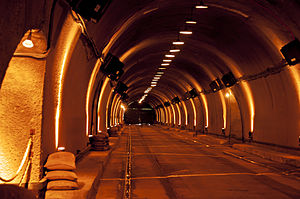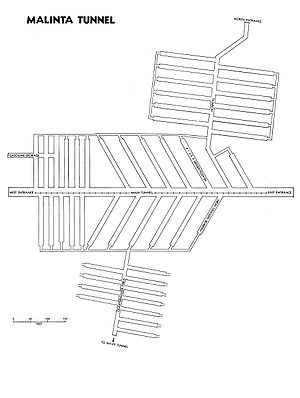Malinta Tunnel
| Malinta Tunnel | |
|---|---|
| Corregidor, Philippines | |
 
Diagram of Malinta Tunnel layout
|
|
| Type | Bunker, underground hospital |
| Site information | |
| Controlled by | United States |
| Site history | |
| Built | 1922–32 |
| In use | 1932–45 |
| Materials | Concrete |
| Battles/wars |
Battle of Corregidor Battle of Corregidor (1945) |
The Malinta Tunnel is a tunnel complex built by the United States Army Corps of Engineers on the island of Corregidor in the Philippines. It was initially used as a bomb-proof storage and personnel bunker, but was later equipped as a 1,000-bed hospital. The main tunnel, running east to west, is 831 feet (253 m) long, 24 feet (7.3 m) wide and 18 feet (5.5 m) high. Branching off from this main shaft are 13 lateral tunnels on the north side and 11 lateral tunnels on the south side. Each lateral averaged 160 feet (49 m) in length and 15 feet (4.6 m) in width.
The Malinta Tunnel derives its name from Malinta Hill, a 390-foot (120 m) rise through which its shaft is bored. Malinta is Tagalog for "many leeches",linta being the local word for "leech".
Its construction, without benefit of new equipment or funds apportioned by the United States Congress due to agreements reached during the Washington Naval Conference, began in 1932 and main tunnel and 25 laterals were completed in 1934. Other construction on laterals continued right up to the start of the war.
The Army Corps of Engineers rented obsolete equipment from Baguio gold miners for a nominal fee and made do with condemned TNT from the Ordnance Department. The explosive delivered was in powder form, and had to be wrapped into makeshift cartridges using magazine pages, which were placed into holes drilled into the rock. Labor was provided by the Philippine Commonwealth in the form of 1,000 convicts from the Bilibid Prison in Manila. A company of engineers from the Philippine Scouts worked on the construction as foremen and clerks.
The cement for concrete used to line the tunnels was bought from the Japanese.
...
Wikipedia
